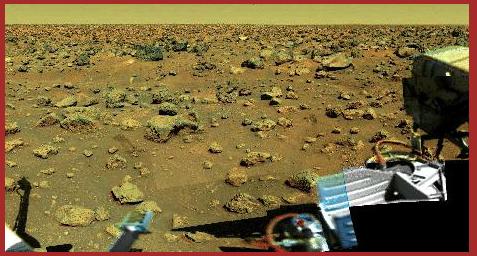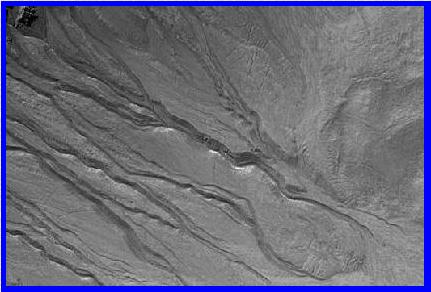 Lesson 7:
Lesson 7:
 Life in the Solar System
Life in the Solar System
|
 7.0
7.0
 Introduction and Overview
Introduction and Overview

|
 |
Figure 7.0.1 In 1976, two spacecraft from Earth, Viking I
In 1976, two spacecraft from Earth, Viking I
and II, landed on the surface of Mars. They carried
several different experiments to test for the presence
of living organisms. (Including cameras to photograph
any passing wildlife!) No evidence of life was found at
either landing site. For more information about the Viking
Mission to Mars, see:
http://nssdc.gsfc.nasa.gov/planetary/viking.html
|
Of all the planets, Mars is the most similar to Earth, at least on the surface.
A good thing to remember is that its size is about halfway between Earth and Moon.
Also, many of its features remind us of both Earth and Moon. When we look at its face,
we seem to recognize familiar phenomena--craters and ejecta like those on the Moon, volcanoes
and valleys like those on Earth. There are four seasons much like on Earth, as the
tilt of the Mars axis differs little from that of Earth. A Martian day
is only slightly longer than a day on Earth (24.6 hrs). The average daytime
temperature on Mars is a balmy 86oF. Nice for sitting outside and
contemplating the scenery from the comfort of a spacesuit! Nights reach a chilling
-211oF. Better pack a sweater!
Perhaps the most intriguing class of morphological features comprises those suggesting
the activity of water on Mars. All sorts of valleys that resemble dry
river courses have kept discussions going, with arguments going back
and forth regarding the relative importance of erosion and tectonics.
But recently the gullies of Mars, beautifully captured in images sent
by the Mars Global Surveyor, clearly indicate the action of some kind
of erosion, presumably by water. (The possibily of CO2 gas-driven
regolith flows, similar to volcanic "lehars" on Earth, cannot be
discounted.) The temperature on Mars,
averaging day and night, is -157oF because of the distance to the Sun (1.5
times greater than the Sun-Earth distance). Thus, any water on Mars
is frozen solid, and is thought to be rather far below the surface.
(Water near the surface would sublimate into the atmosphere and
dissociate, with the hydrogen escaping.)

|
 |
Figure 7.0.2 East Gorgonum Crater on Mars showing
East Gorgonum Crater on Mars showing
channels created by flowing water. The lack of small
meteor impact craters indicates that these features are
extremely young. It is possible that water is still seeping
up to the surface from the layered rocks below.
|
But the gullies remind us that there must be ways to bring liquid to the surface, at least
occasionally. The question then arises whether, perhaps, in the early
history of Mars water was available more readily. If so, Mars might
have been a good laboratory, with sufficient similarity to the early
conditions on Earth, to check the idea that Life must arise,
eventually, if conditions are right.
Are there microfossils or chemofossils hidden away in some old Mars rocks? Some think that the
answer is yes. Heated discussions about a fossil-like structure in a
meteorite from Mars are still going on; what is evidence to some is
just a morphological oddity to others, with no significance as a
fossil.
If Mars was more like Earth in the distant past, its conditions have moved in direction of
the Moon in the time since. The atmosphere is thin, and at night and
near the poles the temperatures drop to extremely low values. The air
is very dry. The ice caps are made of dry ice, frozen carbon dioxide.
The fact that carbon dioxide is the most abundant gas suggests there
is no photosynthesis going on.
The planet looks inhospitable. However, we know that on Earth there are living things
in environments readily identified (by us) as very inhospitable: hot
springs, highly acidic waters, films of metal oxides, high pressure
conditions deep below the surface, poisoned by hydrogen sulfide. If
Life ever existed on Mars it might "hang on", with resting spores bridging times of
stress and waiting for the periods when water makes gullies.
Besides Mars, there are two other planetary bodies that might bear Life in the solar system.
These are Europa and Titan, two big moons belonging to Jupiter and
Saturn, respectively. They too may have water.
|





















